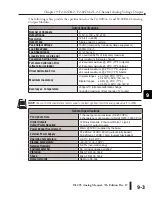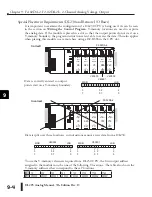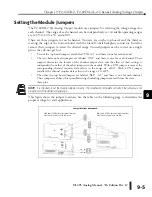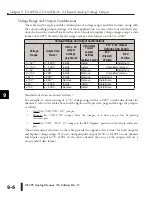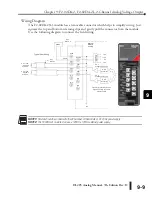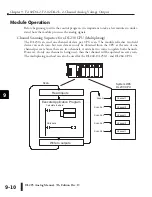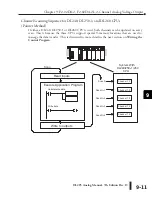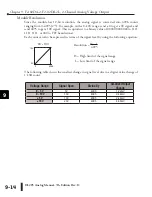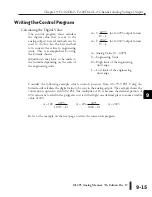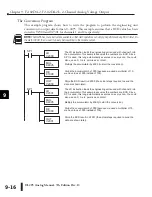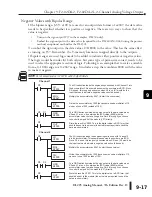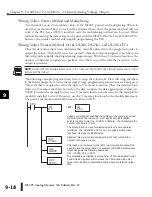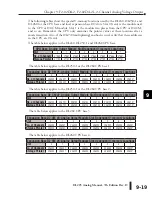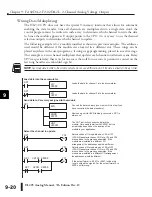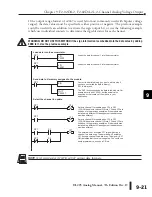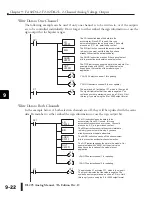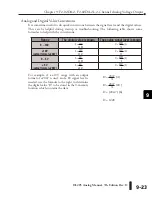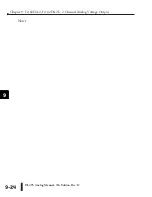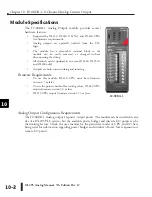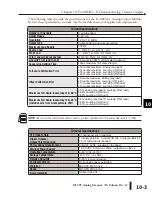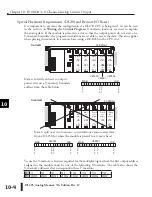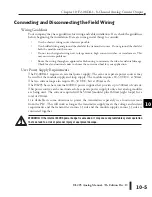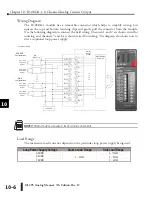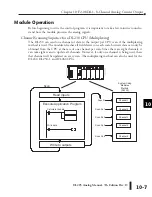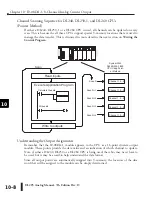
DL205 Analog Manual, 7th Edition Rev. D
9-17
Chapter 9: F2-02DA-2, F2-02DA-2L, 2-Channel Analog Voltage Output
1
2
3
4
5
6
7
8
9
10
11
12
13
14
A
B
C
D
Negative Values with Bipolar Range
If the bipolar ranges (±5V, ±10V) are used or an output data format of ±2047, the data value
needs to be specified whether it is positive or negative. There are two ways to show that the
value is negative:
•
Turn on the sign output (Y37 in the examples, DL230 only).
•
Embed the sign output in the data value (required for the DL240/250-1/260 using the pointer
method, an optional method for the DL230).
To embed the sign output in the data values, OR 8000 to the value. This has the same effect
as turning on Y37. Remember, the V-memory location is mapped directly to the outputs.
If bipolar ranges are used, logic needs to be added to indicate either positive or negative values.
The logic would be similar for both values, but some type of permissive contact needs to be
used to select the appropriate section of logic. Following is an example that re-scales a variable
from a 0–1000 range to a 0–2047 range. It includes a step that combines 8000 with the value
to make it negative.
NOTE:
Do not exceed a value of 2047 for ±2047 output formats.
1
2
3
4
5
6
7
8
9
10
11
12
13
14
A
b
C
D
The LD instruction loads the engineering units used with Channel 1 into
the accumulator. This example assumes the numbers are BCD. Since
X0 is used, this rung only executes when X0 is on (X1 would be the
input that would indicate a negative value should be used).
LD
V2300
X0
MUL
K2047
DIV
K1000
Multiply the accumulator by 2047 (to start the conversion).
Divide the accumulator by 1000 (because we used a multiplier of 10,
we have to use 1000 instead of 100).
OUT
V2000
Store the result in V2000. This is the digital value, in BCD form, that
should be sent to the module (the actual steps required to send the
data are shown later).
ORD
K8000
This ORD instruction imbeds the sign output in the data value when
X0 and X1 are on. It combines the BCD value (8000) with the
accumulator value to make it negative. Omit this rung if you choose
to control the sign bit of the module (Y37) directly.
X0 X1
X0
The LD instruction loads the engineering units used with Channel 2
into the accumulator. This example assumes the numbers are BCD.
Since X0 is used, this rung only executes when X0 is on (X2 would be
the input that would indicate a negative value should be used).
LD
V2301
X0
MUL
K2047
DIV
K1000
Multiply the accumulator by 2047 (to start the conversion).
Divide the accumulator by 1000 (because we used a multiplier of 10,
we have to use 1000 instead of 100).
OUT
V2001
Store the result in V2001. This is the digital value, in BCD form, that
should be sent to the module (the actual steps required to send the
data are shown later).
ORD
K8000
X0 X2
X0
This ORD instruction imbeds the sign output in the data value when
X0 and X1 are on. It combines the BCD value (8000) with the
accumulator value to make it negative. Omit this rung if you choose
to control the sign bit of the module (Y37) directly.
Channel 1
Channel 2
Summary of Contents for DL205
Page 1: ...DL205 Analog I O Manual Manual Number D2 ANLG M ...
Page 2: ...Notes ...
Page 6: ...Notes ...

